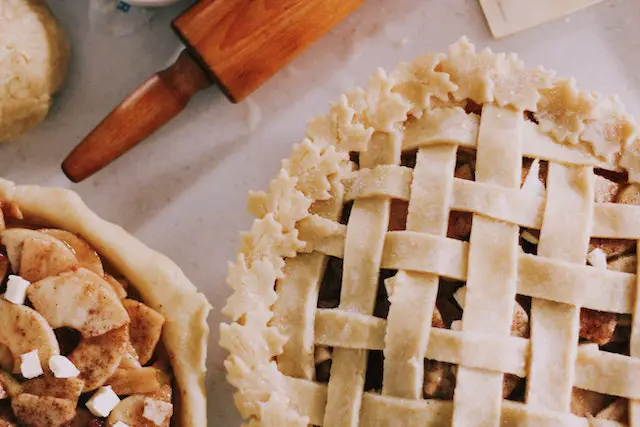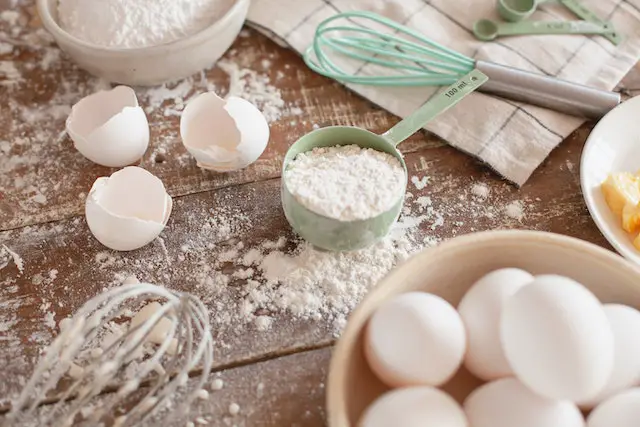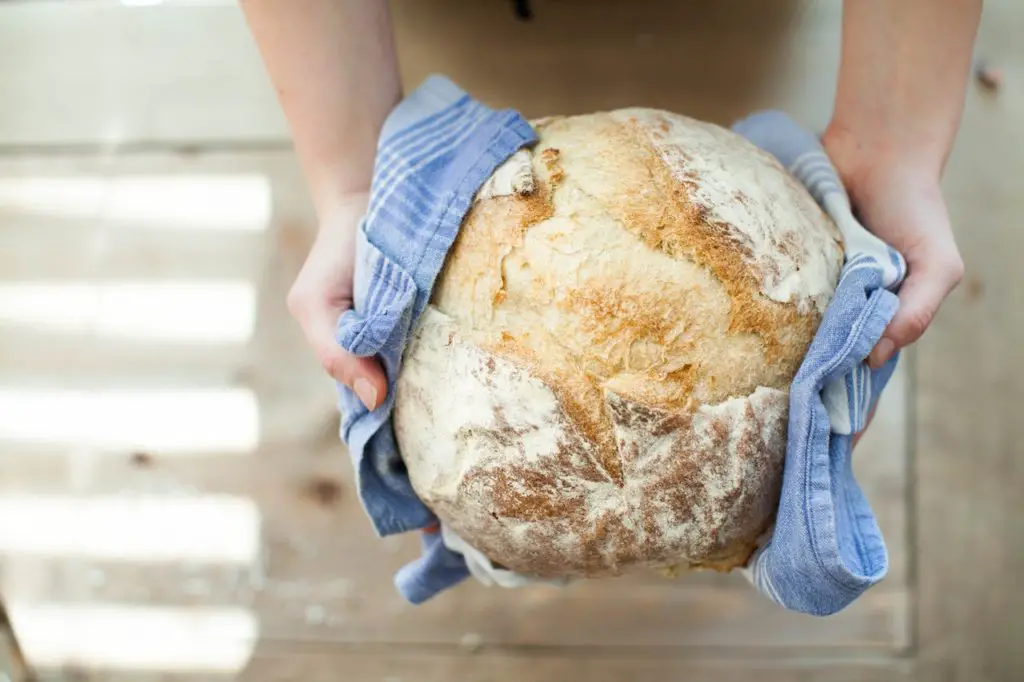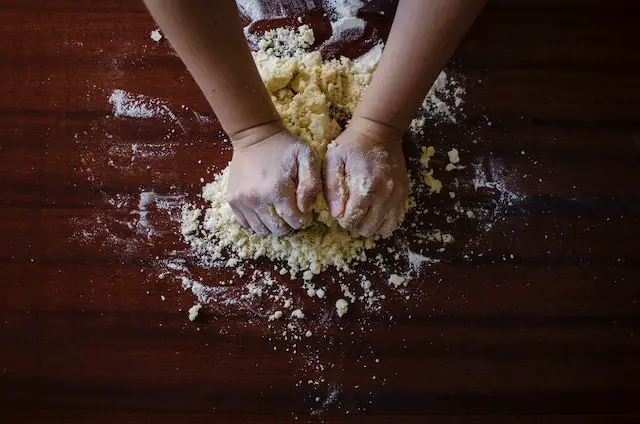Xanthan gum is a staple ingredient for gluten free baking. Most gluten free recipes call for you to add xanthan gum to the recipe, but most gluten free flours already have xanthan gum added to the flour itself. It’s important to know whether the flour you are using already has xanthan gum or if it will need to be added separately to the recipe.
Most gluten free flours already have xanthan gum added, including: Bob’s Red Mill Gluten Free 1 to 1, Better Batter, Cup4Cup, Namaste Foods, GF Jules All Purpose, and Krusteaz Gluten Free Flour. Gluten free flours that do not contain xanthan gum include King Arthur Gluten Free, and Better Batter’s Artisan Flour Blend. Not all gluten free flours will work the same way, so it’s important to know whether you need to add more xanthan gum to a recipe, or if the amount already in your flour is enough.

Bob’s Red Mill Gluten Free 1 to 1 Baking Flour
Bob’s Red Mill Gluten Free Flour has xanthan gum added, and is one of the most widely found gluten free flours. It’s fairly easy to find Bob’s Red Mill at your local grocery store in the gluten free aisle, and some Big Lots stores also carry quite a few Bob’s Red Mill flours. It’s also available on Amazon or directly from the Bob’s Red Mill website. It’s not the most expensive gluten free flour, but the packages in stores are usually quite small, so if you need a lot of it, it may be best to purchase it in bulk.
Bob’s Red Mill Gluten Free Flour also works well in recipes that call for yeast, like breads and pastries. Their website recommends following the recipe as written, and adding extra xanthan gum separately from what’s already in their flour, as xanthan gum can be used to help foods rise and give them structure.
Better Batter Gluten Free Flour
Better Batter now has two varieties of gluten free flour; their Original All Purpose Flour blend, which does contain xanthan gum, and their Artisan Flour Blend, which does not contain any xanthan gum.
The Original All Purpose Flour blend contains a blend of rice flours, tapioca and potato starch, potato flour, and pectin. This flour is great for making pastries, cookies, and donuts, but is definitely not the best for making pancakes. They turn out too gummy in the middle (probably because of the xanthan gum plus the added pectin). Other common complaints on this flour are that it is expensive compared to some other gluten free flours, and it also can give results that are gritty due to the rice flour.

Better Batter’s Artisan Flour Blend does not have xanthan gum or any other gum substitute added to it. This allows you to control how much stretch you add to your baked goods, especially breads and other recipes that call for yeast to be added. This flour is also great to use as a breading for fried foods, because it doesn’t have xanthan gum added. Flours with xanthan gum added tend to get mushy after frying.
Cup4Cup Gluten Free Flour
Cup4Cup has several gluten free flour varieties; Cup4Cup Multipurpose Gluten Free Flour, Cup4Cup Ancient Grains Flour, and Cup4Cup Wholesome Flour,and they all contain xanthan gum. The Cup4Cup Multipurpose Gluten Free Flour contains milk powder in the flour blend as well, so this blend wouldn’t work well for someone with dairy sensitivities or allergies. Their other two flours do not contain milk but are made on shared equipment.
Cup4Cup is not the best option for baking with yeast recipes, but it makes excellent biscuits and isn’t too gritty compared to other options. If you aren’t sensitive to dairy, the Multipurpose Cup4Cup flour is a great option. If you are looking for a whole wheat type of flour, the Ancient Grains flour is probably the closest thing to a whole wheat gluten free option.

Namaste Foods Gluten Free Flour
Namaste Foods Gluten free flour does contain xanthan gum, and it also contains arrowroot starch, which makes it a great flour to use in recipes that call for extra stretchy dough. It’s not the best for pancakes or anything that isn’t baked, because the extra xanthan gum and arrowroot starch give it a rubbery feel. It also isn’t recommended for yeast breads for the same reason. Namaste’s website does have a recipe for yeast bread that they recommend, but otherwise they say that yeast recipes may require “some experimentation”.
GFJules All Purpose Gluten Free Flour
GF Jules All Purpose Gluten Free Flour does have xanthan gum added to it. It does not have brown rice flour, so it is less gritty than some of the other gluten free brands out there. However, a lot of people find that this flour is hard to bake with, and some items come out way too gummy, while baked items don’t rise as they should. It’s also one of the most expensive gluten free flours out there. It seems like some people really like this gluten free flour, but many people who are looking for a consistent gluten free flour for baking choose to go with Bob’s Red Mill or King Arthur instead.
Krusteaz Gluten Free Flour
Krusteaz Gluten Free Flour contains xanthan gum already in the flour blend. This gluten free flour blend has a warning on the label that says it may contain milk, soy, and eggs, so use caution if you have allergies to any of those ingredients. Because of the high content of brown rice flour and sorghum flour, this flour blend can be especially gritty in recipes if you don’t use enough liquids or fats like butter. You may need to make adjustments to some recipes for taste as well, because the sorghum flour leaves a distinct taste that may need to be overcome by adding more sugar to baked goods recipes. The most common complaint for this flour is that the “best by” date is not very long, meaning this flour isn’t very shelf stable for more than a few months. This one is best to buy in smaller quantities unless you use a lot of flour or are baking for a large crowd.
King Arthur Gluten Free Flour
King Arthur is one of the only commercially prepared gluten free flours that does NOT contain xanthan gum, making it perfect for anyone who is allergic or cannot eat xanthan gum. It’s also a great choice for anyone who wants more control over the amount of gum added to their recipes, as some recipes don’t need xanthan gum added at all. King Arthur flour is cheaper than a lot of other gluten free flours, and it works great as a one to one substitute for wheat flour, and it seems to have the best taste with no grittiness at all in most recipes. This flour is the closest to regular wheat flour when used for baking or frying. There are also tons of recipes on King Arthur’s website that are specifically tailored to using their flour in the recipe, and their recipes turn out so well.

Does all gluten free flour have xanthan gum?
Not all gluten free flour contains xanthan gum. Xanthan gum is an ingredient added to gluten free flour to help mimic the elasticity of gluten that is found in regular wheat flour. Because gluten free flour doesn’t have gluten, gums like xanthan gum or guar gum are commonly added to help gluten free dough stretch instead of being dry and crumbly.
What gluten free flour does not have xanthan gum?
King Arthur gluten free flour does not have xanthan gum added to it, and neither does Better Batter’s Artisan Gluten Free Flour. These can be substituted for gluten flour in a 1:1 ratio. You can add xanthan gum to these flours, but it isn’t always necessary. I personally use this flour for almost all of my gluten free recipes and I don’t even add xanthan gum anymore. Gluten free flours without xanthan gum are also best for frying and breading, because the flours that have added gums tend to stay soggy after frying. King Arthur’s gluten free flour seems to hold up the best for frying and breading out of all of the gluten free flours.
What flour can I use instead of xanthan gum?
The best substitutes for xanthan gum are guar gum and psyllium powder. There are other options as well, such as cornstarch, tapioca flour, arrowroot powder, chia seeds, agar agar, and flax seeds. Each of these options work in different ways, and there can be a bit of a learning curve to be able to use these substitutions effectively in a recipe. There are plenty of substitution charts available that can help you navigate using these in a recipe. Sometimes, the recipe itself will mention substitutions that you can make that have already been tested in that particular recipe.
What happens if you don’t use xanthan gum in gluten free baking?
If you don’t use xanthan gum in gluten free recipes, the end result of the recipe can be crumbly and dry. This is most noticeable in bread recipes, because without the gluten to make the dough stretch and give, there needs to be something added to give the gluten free dough that same elasticity.
There are many recipes that don’t have to have xanthan gum added in order to be successful, but for bread recipes it’s always wise to add some type of gum or stretchy flour to help the bread feel fluffy in the middle when cooked. Be careful not to use too much xanthan gum though, or the end result can be too gummy and it may feel under cooked in the middle.

Can I omit Xanthan Gum from a recipe?
Xanthan gum can be omitted from many gluten free recipes without causing any issue at all. Since most gluten free flours already have xanthan gum added, it’s likely that there will be enough xanthan gum in the recipe just by adding flour, unless you are using a gluten free flour that doesn’t contain xanthan gum at all.
I’ve been cooking and baking with gluten free flour for over ten years, and I’ve personally found that there are some baked goods that I prefer not to use xanthan gum in at all. Pancakes, waffles, and soft muffins are usually better without xanthan gum, because if I add it, the middle of the pancake or muffin (especially pumpkin muffins which tend to be more moist) just feels mushy and under-cooked. Bread recipes almost always need at least a little bit of xanthan gum added just to keep the final product from being dry and crumbly.
I use King Arthur gluten free flour specifically because it doesn’t contain xanthan gum and I can add it if I would like, or leave it out completely. You can also use homemade gluten free flour blends to achieve the same result if you would like to be able to adjust the amount of xanthan gum that is used in your recipes.

